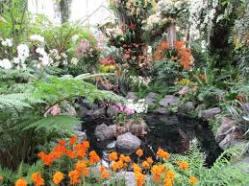“A garden is a delight to the eye and a solace for the soul,” (Sadi). When people bring up the subject of gardening, the first image that pops into my mind is one of a little old lady holding her spade outside, smiling and surrounded by beautiful petunias and sunlight. My next thought is, why would she, or anyone else for that matter, want to sit on the hard ground for hours and get covered in dirt and sweat only to have her plants die within weeks? There are many people who share my skepticism of gardening, but there are just as many who, like Sadi, fully believe that the act of gardening can spread a blanket of complete tranquility over those who participate in it. Despite the obvious dirty work involved in gardening, could it be true that caring for plants really does promote inner peace?
On the quest for answers, my search results immediately led to the discovery of horticultural therapy. “Today, horticultural therapy is accepted as a beneficial and effective therapeutic modality [that] is widely used within a broad range of rehabilitative, vocational, and community settings,” (AHTA). Institutions all over the world use horticultural therapy as a way to help people with both mental and physical disabilities and trauma find a road to recovery. The participants nurture plants in gardens specifically laid out for easy gardening and stress relief. In one study by the University of Hyogo in Japan, researchers found that the physical actions of therapeutic gardening stimulate areas of the brain such as sensory-motor areas and association areas, leading to improvement of damaged brain function in patients who suffer from cerebrovascular diseases (Mizuno-Matsumoto). Patients like these along with those who suffer from cardiovascular disease, dementia, anxiety, depression, and many others experience the same gardening therapy. Their work, though at times difficult, leads to healing and relaxation in most cases.
Although horticultural therapy is a proven treatment that heals patients, not everyone who has found peace in gardening suffers from professionally diagnosed cases. Everyday people in cities across the globe sustain gardens that range from simple potted lilies to large vegetable patches. When asked about peaceful gardening, local Oklahoman Rebecca Ballard said, “there’s just something about putting seeds in the ground and watching them grow; it makes you feel so good inside, and a sort of tranquil feeling sets in over everything,” (Ballard). In her history of gardening, Rebecca has successfully harvested vegetables in her backyard including squash, cucumbers, tomatoes, red and green peppers, carrots, and potatoes. She says, “even though you get dirty, the hard work pays off in the end,” (Ballard).
In order to further my understanding of exactly how peaceful plants can seem, I decided to visit the Myriad Botanical Gardens in downtown Oklahoma City. My two-hour visit to the indoor sanctuary indeed resulted in a greater appreciation to those who garden, for the entire greenhouse-esque building omitted the most powerful sense of nature I had felt in a very long time. Every glass wall was covered in vegeatation from top to bottom, and my short walk among the beautiful greenery alone instilled an incredible calmness in me for the remainder of the day. Walking through the beauty and dynamism of nature reminded me that there are greater things at work in the universe than humans, which humbled me significantly. I came to the realization that the people who work so hard to achieve the awe of the Myriad Gardens must truly gain harmony with the world and themselves after experiencing the gardens they helped to bloom.
My last attempt to discover the peace of gardening led me to purchase a plant and see if I could achieve the tranquility everyone seems to be talking about from watching it grow. For four weeks now I have been caring for an aloe vera plant that lives in my room at OCU. Even though aloe plants do not require much maintenance, I enjoy being around it. I water it every Wednesday, and already its color has gone from a sickly slightly brown to a vibrant bright green. Knowing that I helped a living thing to recover from illness made me incredibly happy; as a result the aloe vera plant has boosted my everyday morale and instilled more happiness in my life. I look forward to the days I can feed the plant, and I enjoy opening the blinds for it every morning. I do not even have to get dirty to take care of my plant, because it lives in a pot rather than an outdoor garden. One day soon I get to transfer the plant to a larger pot where it can grow even bigger and healthier than before.
Gardening extraordinaire Cheryl Patterson must have been correct when she said to “surround yourself with special things that you enjoy, that will give you a moment to pause, reflect and just feel good, “(Patterson). My search into the mystery of gardening has led me to change my opinion that gardening is only grueling work for old ladies; I have found that gardening can induce feelings of calm tranquility and harmony with yourself and the world, and yes, plants must be peaceful after all.


I really liked how you started out your essay with a quote and what you picture when you think of gardening. It was really neat that you were able to find someone here in your home state that did this type of therapy. Like you stated on my blog I think you should add some statistics. One thing I should have added to mine was more description. You do an awesome job of painting the pictures in my head of the lady planting a gardening in your first paragraph.Your ending paragraph wraps everything up and doesn’t leave any open questions! Good topic!